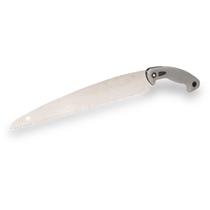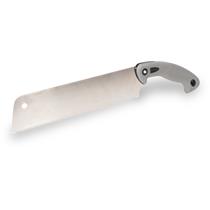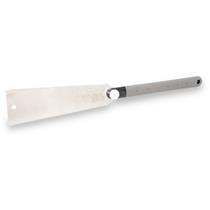When precision, efficiency, and versatility matter, the VAUGHAN Bear Saw® is the tool for the job. These Japanese-style pull saws offer superior performance and optimal control with every stroke. They cut on the pull stroke unlike most western saws that cut on the push stroke. This allows for more precise cuts, which is especially beneficial with fine woodworking, flush cuts, and cutting on curves.
From their innovative cutting design to their durable construction and wide range of blade options, there are several features that make the Bear Saws® a must-have in your toolbox.
1. Precision Cutting
Unlike traditional push saws, the VAUGHAN Bear Saw® cuts on the pull stroke. This innovative design reduces the risk of blade buckling and binding, giving users greater control with every cut. The pull motion makes the sawing process smoother and less fatiguing—which is especially important when completing projects that take more time. The thinner blade removes less material with each stroke, resulting in faster, more efficient cuts.

2. A Blade for Every Task
Regardless of the material or the job, there's a Bear Saw® blade to match.

Medium/Coarse Blade: ideal for heavy-duty tasks like framing, pruning, and working with treated lumber or logs
Medium Blade: offers excellent control for smoother materials like plywood, molding, and 2x4s
Fine/Medium: doubled-edged blade perfect for dovetails, moldings, flush cuts, and more
Extra Fine Blade: ideal for PVC and ABS pipe, plywood, and particle board.
Extra Fine/Fine Blade: mini doubl-edged blade ideal for finer tasks or tight spaces; provides high precision on dovetails, moldings, and small cuts.
Every Bear Saw® blade is compatible with both available handle styles—curved or straight, allowing users to choose based on comfort or task requirements. Handles and blades can be mixed and matched, plus, the saws are designed for quick disassembly, making them easy to store or transport between jobsites.

3. Built to Last
Each Bear Saw® blade is crafted from high-quality spring steel, offering both flexibility and strength. A protective plating resists rust and corrosion, ensuring the saw remains reliable even in challenging environments. The blade’s tri-edged teeth are specially ground and razor sharp, ensuring clean and accurate results. Additionally, the teeth are impulse hardened to maintain sharpness over time, so you spend less time sharpening and more time getting the job done.

So, whether you’re trimming molding, cutting pipe, or building a deck, the VAUGHAN Bear Saw® is the ultimate partner for precision and performance. Its innovative design, durable construction, and flexible blade options make it top choice for both professionals and DIYers.
FAQs
General Use & Technique
Q: How is a pull saw different from a regular saw?
A: Unlike traditional push saws, the Bear Saw® cuts on the pull stroke, which offers more control, less effort, and cleaner cuts with reduced blade flex.
Q: Do I need to apply pressure while cutting?
A: No—use light, steady strokes. The saw’s design and sharp teeth do the work with minimal force.
Q: Can I use this saw on hardwood or metal?
A: Bear Saws are best for wood, plastic (PVC/ABS), and soft materials. For metal, use a metal-specific saw.
Blades & Handles
Q: Are Bear Saw® blades interchangeable?
A: Yes. All Bear Saw® blades are compatible with both curved and straight handles—choose based on comfort or task.
Q: How do I change the blade?
A: Loosen the handle’s screw, slide out the old blade, and insert a new one. Re-tighten—no tools required for most models.
Care & Maintenance
Q: How do I clean and care for the saw?
A: Wipe the blade clean after use. Avoid moisture exposure. Apply a light oil coating for long-term storage.
Q: Can I sharpen the blade?
A: No. Bear Saw® blades use impulse-hardened teeth that stay sharper longer, but they’re not designed for resharpening.
Q: How should I store the saw?
A: Use the protective sheath or detach the blade for compact, safe storage. Store in a dry place to prevent rust.
Troubleshooting
Q: Why does the blade bind while cutting?
A: Binding is usually due to:
- Excessive pressure
- A dull or incorrect blade
- Misalignment during the cut
Q: Why is the blade flexing?
A: Bear Saws use thin blades for precision. If pushed too hard or angled improperly, they may flex. Use gentle, controlled strokes to prevent bending.




